2023 Playbook: How to Create a Revenue-Generating Sales Plan [Template + Examples]
Casey O'Connor
A sales plan is a detailed, A – Z roadmap for salespeople that outlines the various stages, executable actions, methodologies, outcomes, and goals of the sales process.
The document provides the sales team with an action plan for executing their roles and responsibilities in supporting your company goals.
In this article, we’ll go over all the steps you need to take (and exactly what to include) in order to create an effective sales plan as well as examples, templates, and proven tips.
Here’s what we’ll cover:
- What Is a Sales Plan?
- Why Do I Need a Sales Plan?
- How to Create a Sales Plan
- Types of Sales Plans
- How to Measure Sales Progress
- What to Include in a Sales Plan Template
- Sales Plan Template
- Sales Plan Examples
- Tips for Creating a Winning Sales Plan
What Is a Sales Plan?
A sales plan is very similar to a business plan, except that it focuses entirely on sales activities. It’s an all-encompassing playbook that spells out everything a salesperson might need to know about what they’re working toward within their company, including:
- Strategies or methods to adopt
- Action steps to follow
- Team players, their specific responsibilities, and the skills required to do their jobs
- Potential pitfalls and challenges
- Individual and team-wide, short-term, and long-term goals
An effective sales plan should be very thorough, and should outline for your salespeople all the various steps — and their potential outcomes — they will need to take in order to play their part in meeting the company’s targets.
A sales plan is meant to help sales reps understand their specific roles and responsibilities, and how their actions and outcomes contribute to the bigger picture.
Like a business plan, a sales plan is a customizable document and should reflect the specifics of your company or small business. What you include in the document — and how you go about creating it — will be unique to your scenario.
With that being said, there are some guidelines and best practices to follow to ensure your sales plan is as effective as possible. We’ll go over all of those later in this article.
First, let’s look at some of the reasons why it’s so important to make a sales plan.
Why Do I Need a Sales Plan?
For many sales reps, the name of the game is closing deals. It can be easy to lose sight of the process in favor of converting as many leads as quickly as possible.
But solidifying and systemizing the sales process is critically important. Creating a sales plan will help you:
- Maximize the efficiency of your sales process by determining which strategies and methods are most effective with your target market
- Identify a variety of targets and goals, and encourage your sales reps to continually strive to meet them
- Track individual and collective performance data from every stage of the sales process, which will help fine-tune your sales process and determine your budgeting needs
Though it may require some time and effort on the front end, creating a sales plan will pay off in spades in the long run.
Systemize
It doesn’t matter how skilled or talented your sales team is — if they’re not efficient in their sales activities, they will never reach peak performance.
In fact, most top-performing companies report that their sales activities are carefully structured, far more so than average or underperforming companies.
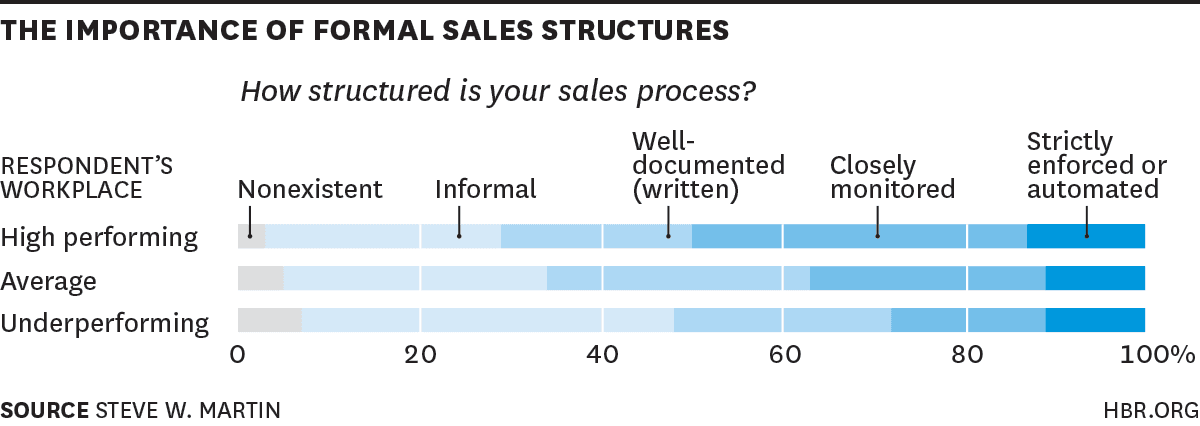
Having a structured system allows your sales team to meet their sales goals more quickly and easily. The detailed roadmap of the sales plan enables your reps to waste no time deciding what to do next, wondering whether what they’re doing is working, or how close they are to meeting their goals.
Motivate
One of the most effective ways to motivate a sales rep is through expertly crafted sales goals. It’s important that your goals are lofty, and will drive your business forward, but they should also be achievable.
Using a SMART goal framework will help you create short-term and long-term, individual and collective goals that are challenging, but attainable. 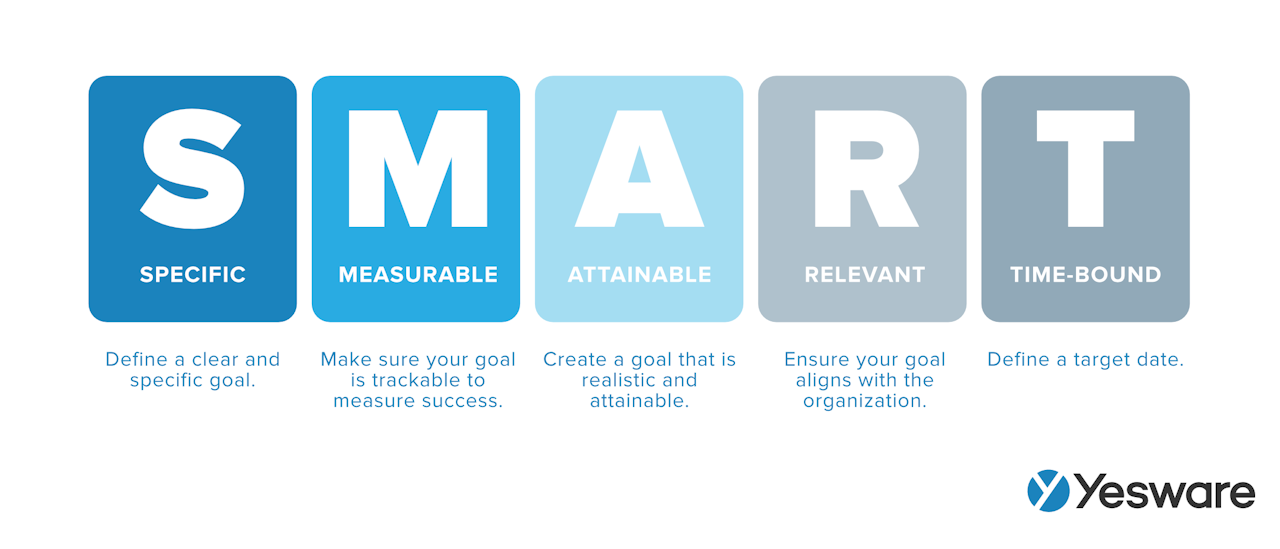 The process may seem tedious, but it’s worth it. If you set goals that are unreachable, your reps will get burnt out and eventually stop trying. Setting the bar too low is a recipe for underperformance. It’s worth it to follow the SMART structure to ensure your goals are appropriately motivating.
The process may seem tedious, but it’s worth it. If you set goals that are unreachable, your reps will get burnt out and eventually stop trying. Setting the bar too low is a recipe for underperformance. It’s worth it to follow the SMART structure to ensure your goals are appropriately motivating.
Track
Once you’ve set effective goals, you also need to be able to see what steps and actions are helping you meet them, and which need some fine-tuning.
This too may seem like an exercise in futility, but carefully tracking your sales KPIs has a ton of benefits.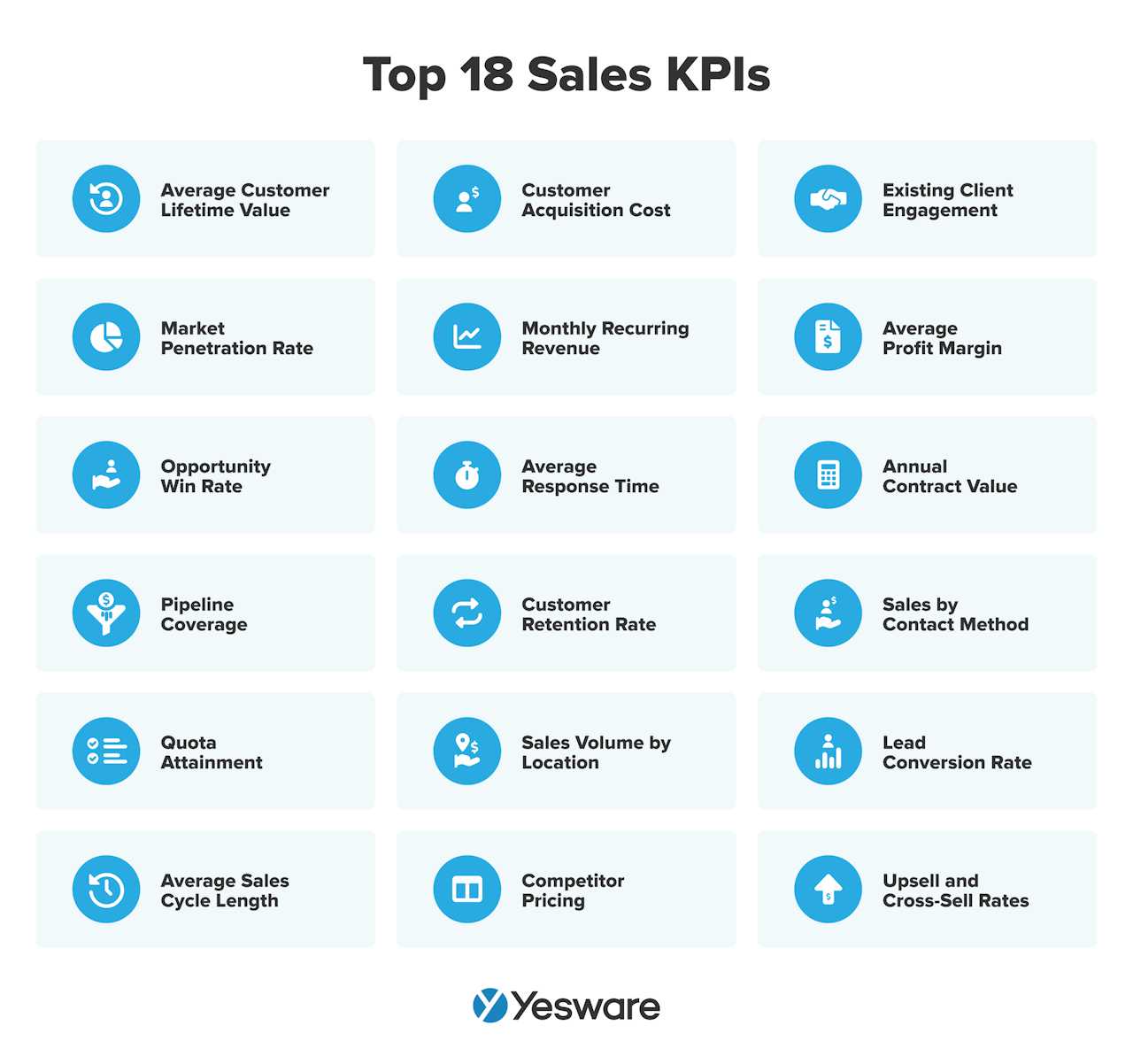 It’s important that your sales team understands that this isn’t meant to be an attempt to micromanage them. Instead, this data will help the company know where to focus its efforts and resources as the business continues to grow.
It’s important that your sales team understands that this isn’t meant to be an attempt to micromanage them. Instead, this data will help the company know where to focus its efforts and resources as the business continues to grow.
How to Create a Sales Plan: 7 Steps + What to Include
Although your sales plan will be unique to your company’s current operating status and future goals, there is a relatively standard process that will help most sales managers create one to suit their needs.
These seven steps will help you know where to start — and what all to include — in your sales plan.
1. Mission Statement & Positioning
Before you start nailing down the specifics of your goals and sales actions, it’s important to have a clear understanding of the big picture. What is your company’s purpose? What do you do and why do you do it? What are your company values? All of these things come together to form a company’s mission.
Creating a mission statement is an all-hands-on-deck exercise. Your company’s mission is developed by and given contributions from many departments. Be sure to consult with your marketing, account management, and content management teams, along with any other stakeholders that are impacted by the company’s larger purpose (in other words, everyone!).
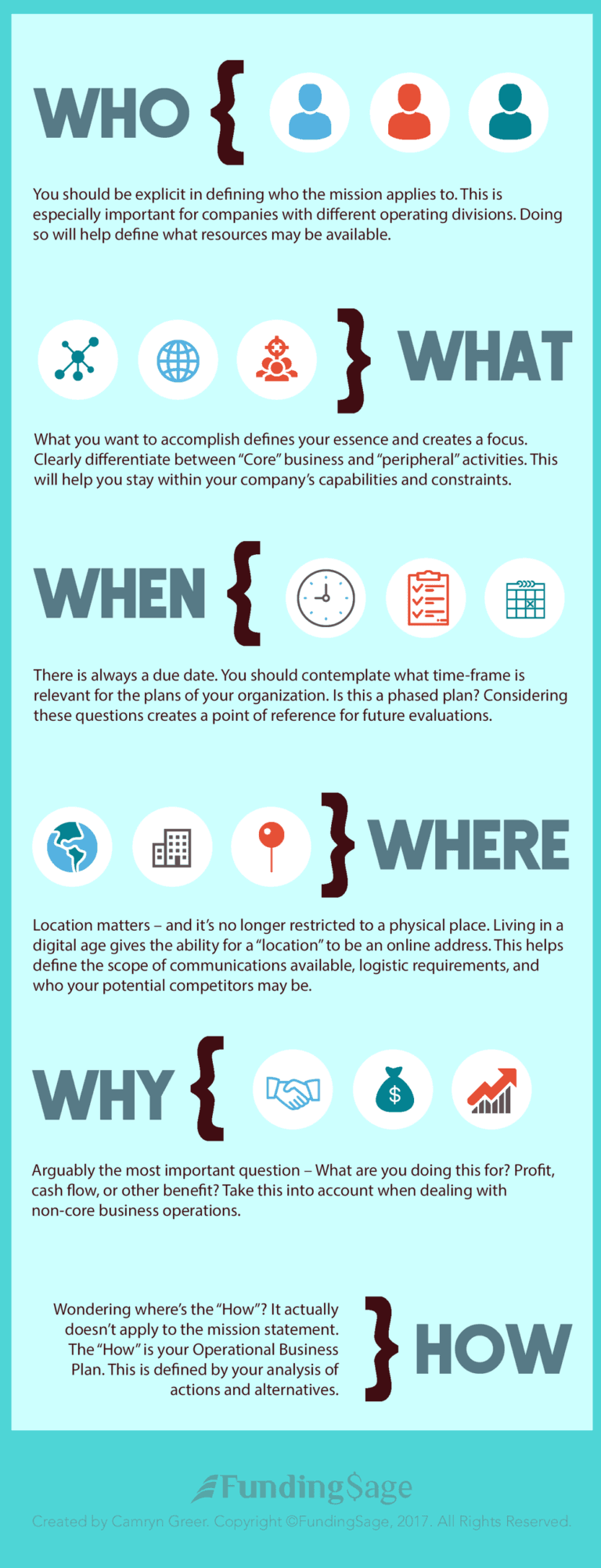
It’s also important during this step to acknowledge your company’s current position in the market. Who are your main competitors? What is the value you offer that sets you apart? This isn’t necessarily part of your mission statement, but it does help your sales team understand where they currently fit in the bigger market picture.
2. Goals
Once you’ve zoomed out and gotten a handle on the higher-level ideals and values of your company, it’s time to dive into the nitty-gritty.
Here’s a process for setting effective sales goals: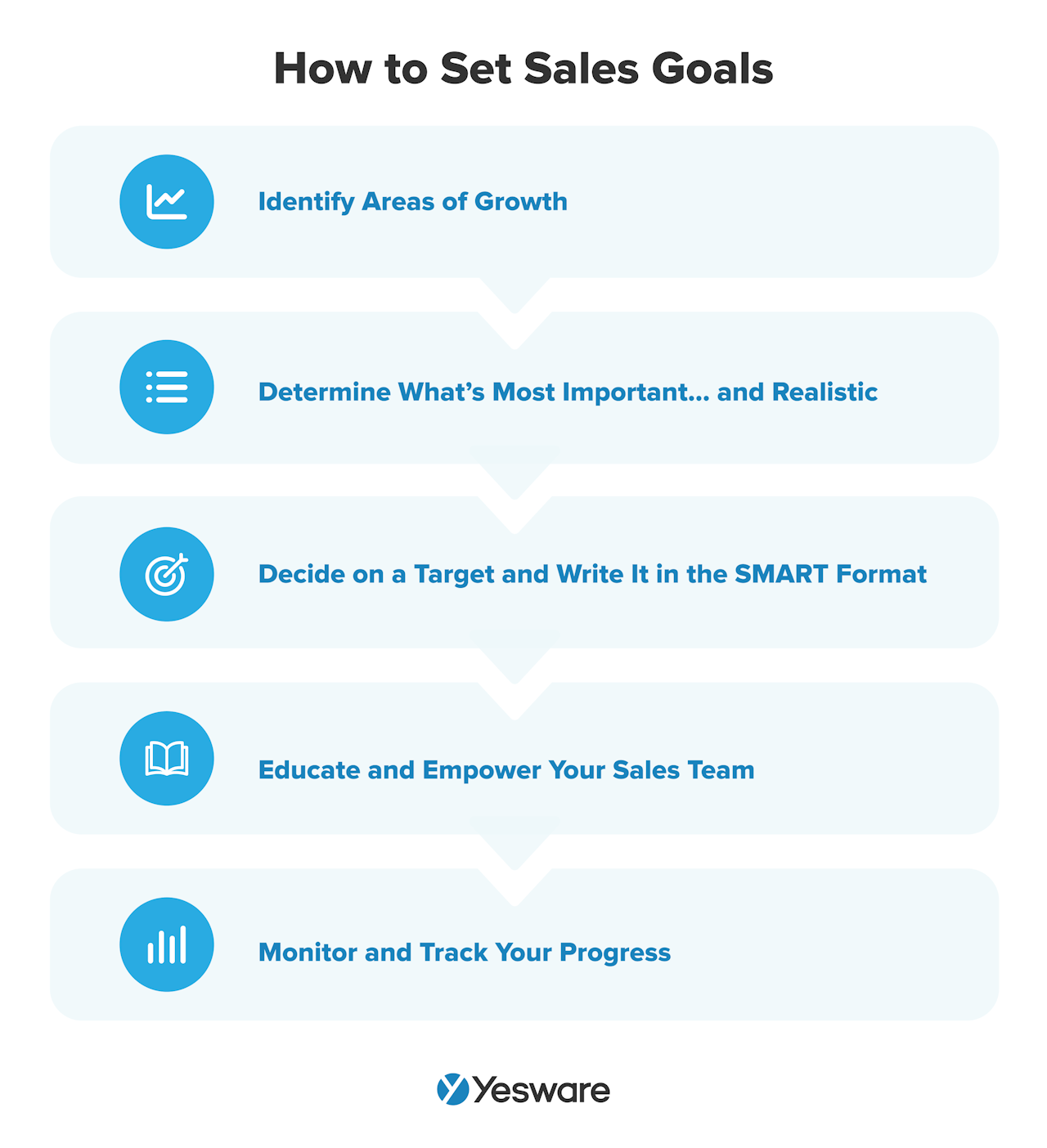 A huge portion of your sales plan will be spelling out your short-term and long-term goals. These goals should be data-driven using historical sales data, and should also address individual, team-wide, and company-wide targets. Goals can include things like revenue, profit margin, total volume, or conversion rate.
A huge portion of your sales plan will be spelling out your short-term and long-term goals. These goals should be data-driven using historical sales data, and should also address individual, team-wide, and company-wide targets. Goals can include things like revenue, profit margin, total volume, or conversion rate.
Do not cut corners in this step. The more specific, the better, and you should consider setting smaller, highly targeted goals for every stage of the sales pipeline.
For example, a high-level goal may be to close 100 deals in a month. That’s a good start at a SMART goal, but challenge yourself to go several steps further. Reverse engineer those 100 deals, and look at all of the steps that happened before close that helped you arrive there.
How many cold emails did it take to close a single deal? How many phone calls are reps making before qualifying a prospect? How is your social media engagement? Your sales process map can help you identify and target each individual step in the process, so you can create smaller, stepping-stone goals.
Here’s a general structure:
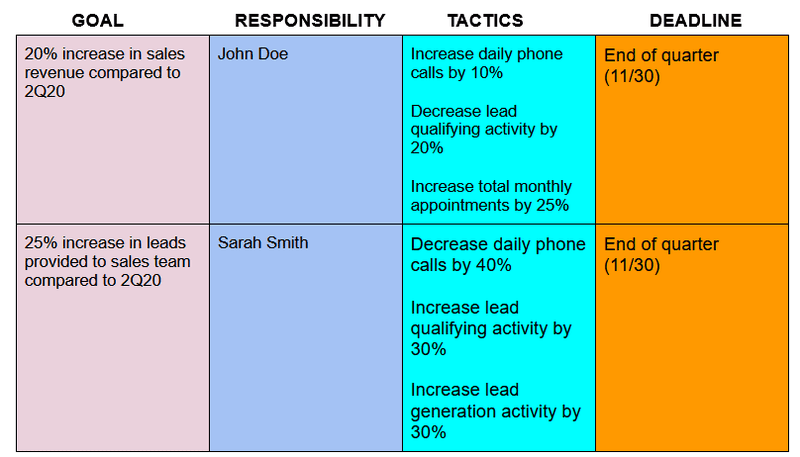
One last tip: make sure to set goals for activities that are directly within a sales rep’s control — things like how many phone calls they make in a day, or how long their demo takes to present — and the outcomes that are driven by those activities (like revenue or number of deals closed).
3. Sales Team Organization & Structure
Here is where you’ll outline your team roster, so to speak. This section of your sales plan should start with an overview of your current sales team, as well as the specific roles and responsibilities of each team member.
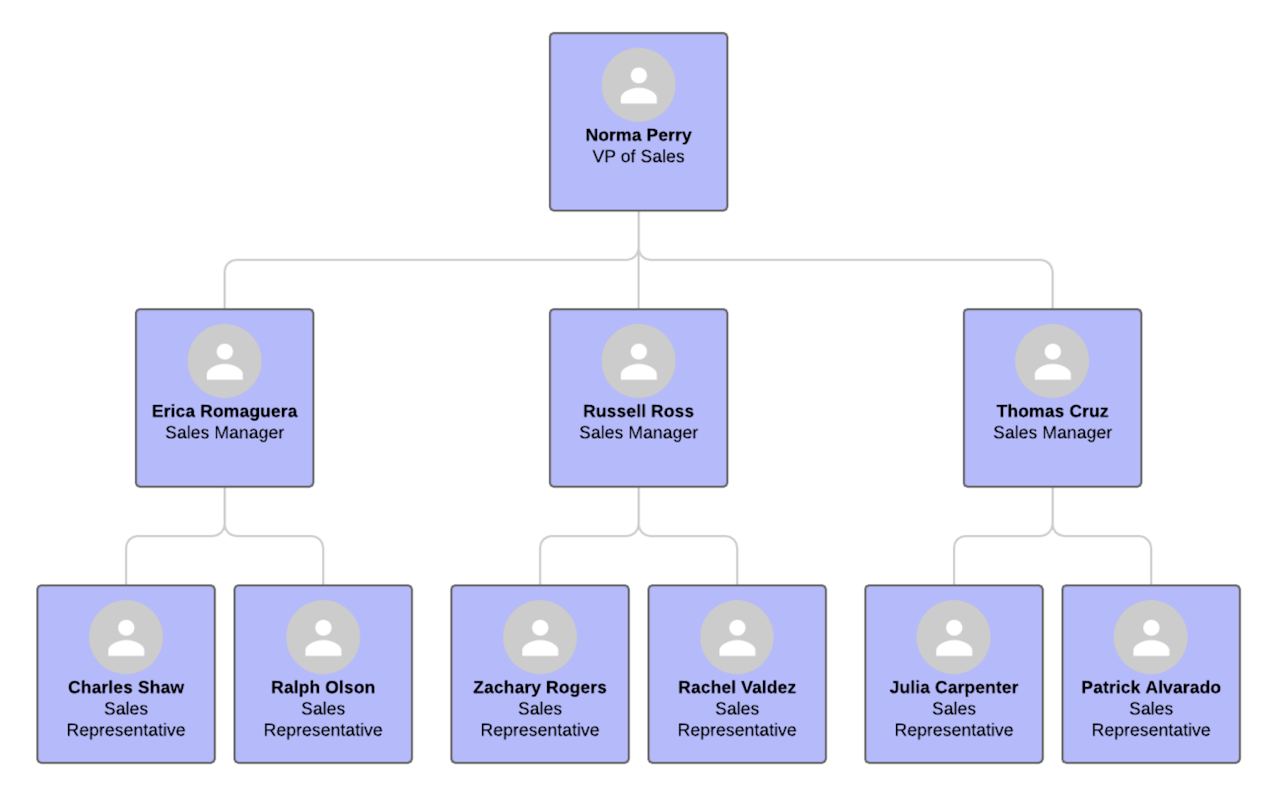
Beyond that, it should also outline the specific skills and/or training that your sales reps currently possess, and what they (ideally) still need in order to be successful. You should also consider including projections for future growth or openings on the sales team. Similarly, you may consider including your compensation plan within the sales plan.
Some of this section will be forward-looking and dependent on your sales budget — don’t exclude something just because it’s not happening now or seems too expensive. These projections will help further shape your revenue goals and allow you to budget appropriately.
This section should rely heavily on self-reports from your sales reps. Take the time to interview them individually about how they view their role and what they currently take responsibility for within the sales process.
There are no right or wrong answers here, so be sure to let your reps know that this isn’t a performance evaluation. The point of gathering this kind of input is to see, from a high-level perspective, which responsibilities are currently well-served, and which need more attention.
4. Target Market & Buyer Persona
As important as it is to clearly understand the internal workings of your sales process, it’s just as important to outline things from the customer’s perspective.
Your sales plan should include detailed information about your target market and buyer persona. Clearly define your ideal customer persona — their demographics, challenges, goals, and how your USP serves their needs and pain points.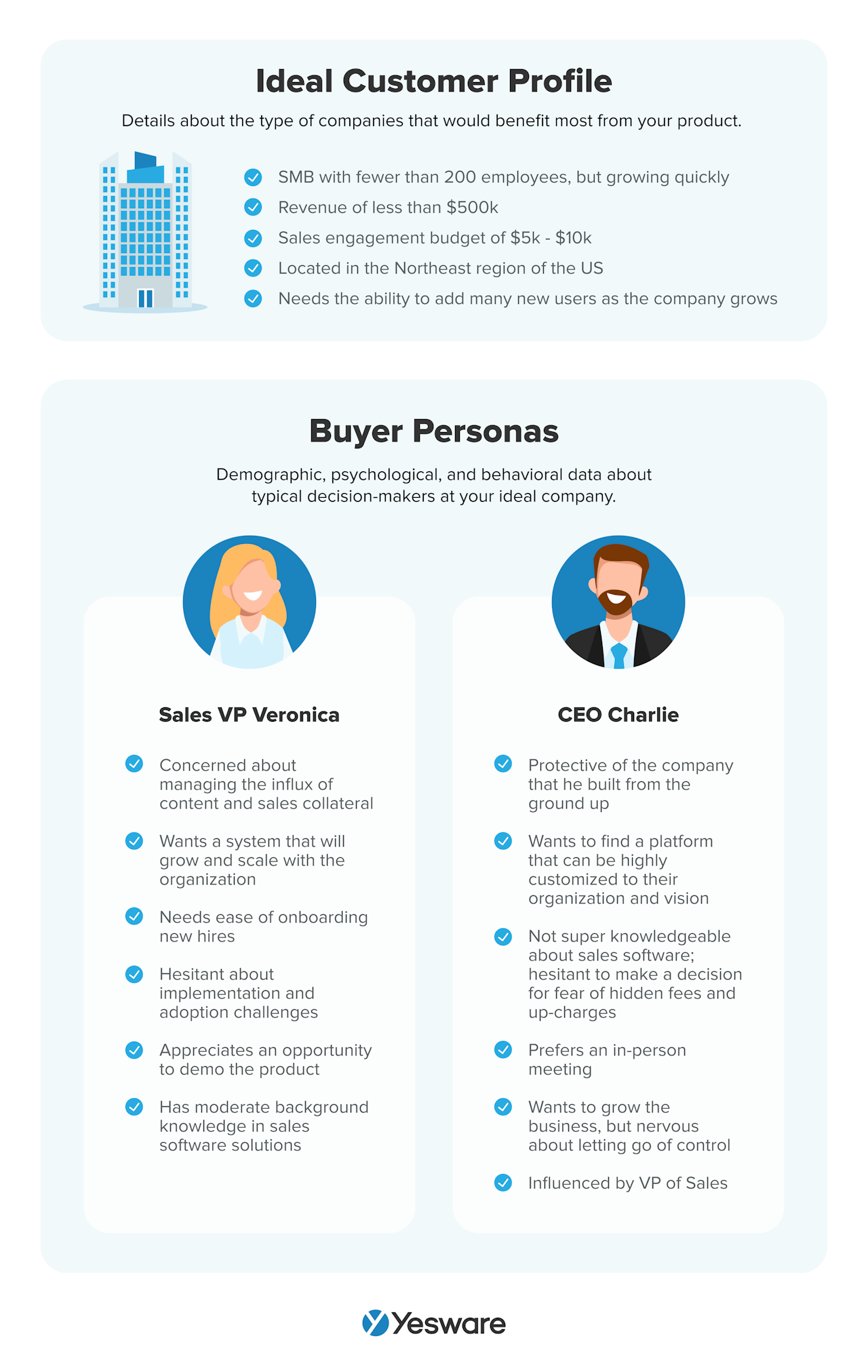 Like all other parts of your sales plan, this section is fluid, and can and should be adapted over time. As your small business grows, make sure to update or expand your target markets and customer personas.
Like all other parts of your sales plan, this section is fluid, and can and should be adapted over time. As your small business grows, make sure to update or expand your target markets and customer personas.
5. Sales Strategies & Methodologies
In this section, you’ll want to give an overview of the various sales methodologies that are most successful for your target market, as well as the actionable steps required for each one.
This doesn’t mean that you need to adopt one approach and stick with it. Many top-tier sales teams use a hybrid approach to sales strategies, combining a variety of methods depending on the rep and the customer.
For example, you may find that inbound leads respond best to a value-selling approach.
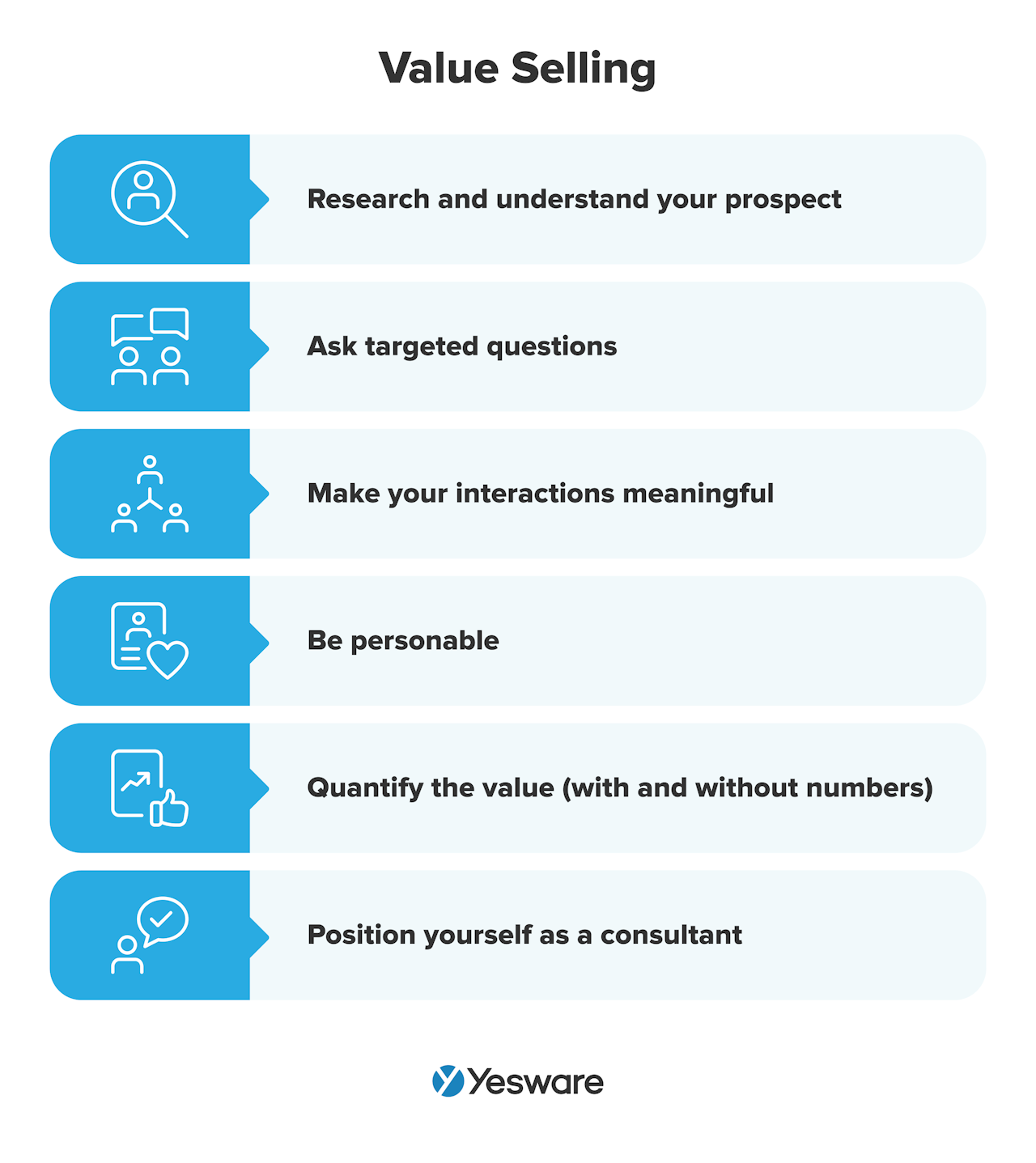 And you may find that outbound leads are more receptive to consultative sales strategies.
And you may find that outbound leads are more receptive to consultative sales strategies.
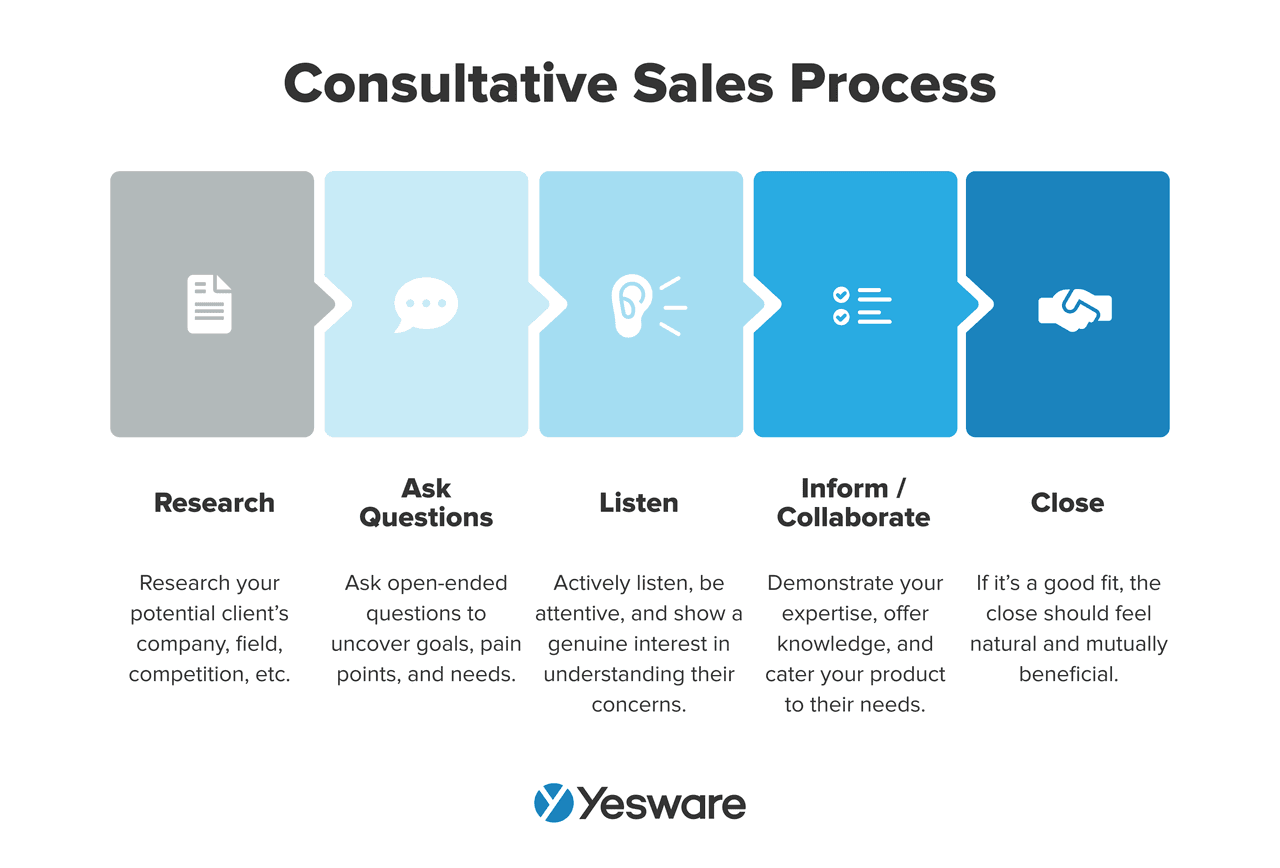 Be specific and all-encompassing here, as individual reps’ training and comfort level may come into play. If there are various paths to success, be sure to note that.
Be specific and all-encompassing here, as individual reps’ training and comfort level may come into play. If there are various paths to success, be sure to note that.
This section works best when it’s laid out according to each stage of the sales cycle.
The sales landscape is changing faster than ever, particularly with the rise of social selling. With that in mind, here’s another reminder to update this section with best practices as you continue to adopt and practice new strategies.
6. Sales Execution & Action Plan
If the sales organization structure section is your roster, then the execution & action plan is your playbook.
Here is the real “meat” of your sales plan. This section is where you will outline the very specific sales activities, timelines, deadlines, and milestones that you expect to take place throughout the sales process.
Be as specific as possible here. “Make 200 cold calls” is far more executable than “Call prospects.” The SMART goals and sales strategies you outlined will drive your execution plan. Include all relevant deadlines, as well as the individuals directly responsible for meeting them. It can be beneficial to break this section down into monthly, quarterly, and yearly timelines.
Tip: Grab this free interactive worksheet that helps you identify the number of calls, conversations, new opportunities, and deals needed to hit your quota each month.
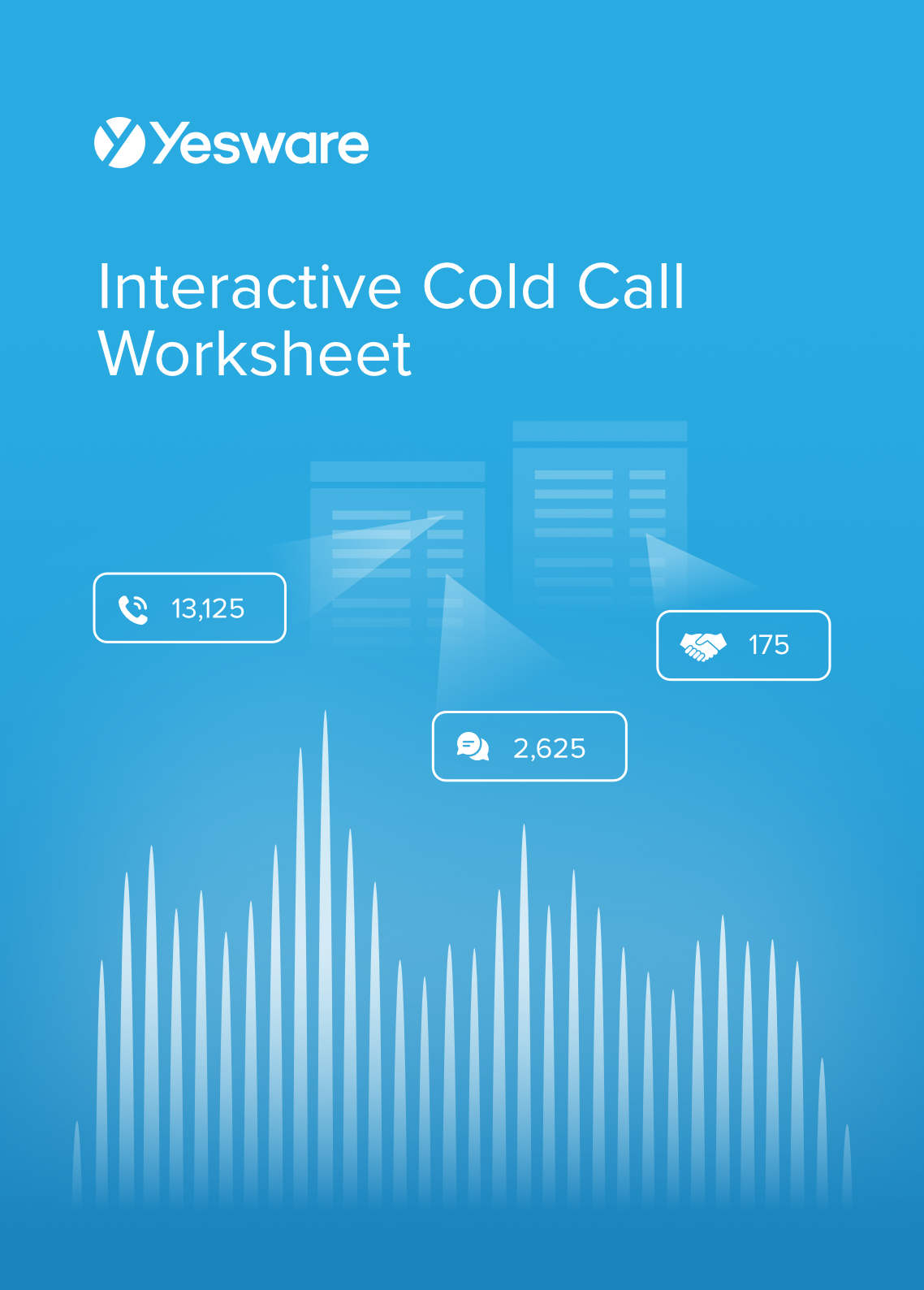 Interactive Cold Call WorksheetFully customizable worksheet that pinpoints roughly how many cold calls you need to make each day and in total for the month in order to hit your quota.
Interactive Cold Call WorksheetFully customizable worksheet that pinpoints roughly how many cold calls you need to make each day and in total for the month in order to hit your quota.
The specificity here will serve two primary purposes.
First, it will be an enormous help to your sales team. There’s no better way to learn on the job than with a step-by-step manual. It also makes the onboarding process very smooth.
It will also allow you to pinpoint which stages of your sales process are converting well, and which need help. It can show you where your sales team’s energy is currently going and where it’s most needed. If, for example, you see that most reps are spending 70% of their time prospecting and still not meeting their quotas, you may want to reconsider your marketing plan.
7. Measure KPIs
The last part of your sales plan involves measuring and analyzing your sales KPIs. What you measure and how you measure it will depend on your specific company, but it’s important to standardize them across the company so that everyone is working toward — and knows exactly how to achieve — the same sales targets.
Most companies choose to track both primary metrics — the ones that measure your overall, big-picture progress — and secondary ones that indicate levels of success throughout the various stages of selling. We’ll go over some of these in the next section.
A robust CRM can help you manage and track the many moving pieces of the sales process.
Types of Sales Plans
One of the most useful things about sales plans is that you can create one for just about any scenario your sales team might encounter.
Whether you’re entering a new market, launching a new product, or simply wanting to grow your revenue, a sales plan specific to your goals can make all the difference in your success.
Here are a few examples of the different types of sales plans your team might create.
Annual/Quarterly/Weekly Sales Plan
One straightforward way to write a sales plan is by determining goals for a specific time period.
Most sales teams create weekly/monthly/quarterly/annual goals; a sales plan can help everyone involved achieve those goals.
A sales plan created around a specific time period should include revenue goals, specific sales strategies and tactics, and a means for measuring progress.
Here’s an example of a quarterly sales plan:
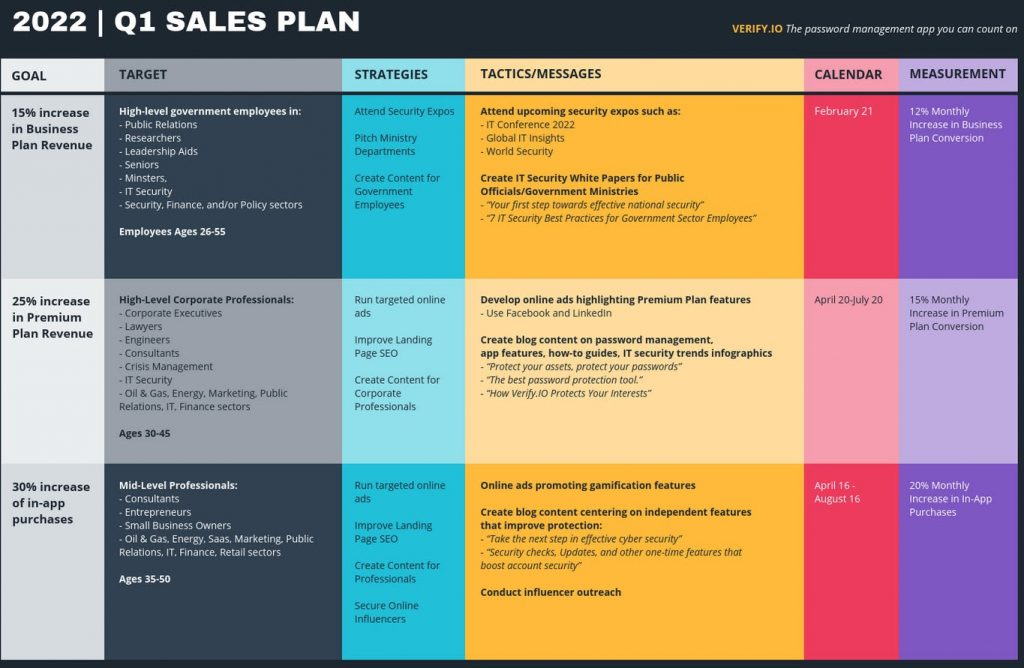
New Product Sales Plan
A new product sales plan details the goals, strategies, tactics, and people involved in launching a new product. It’s essentially a blueprint for how to generate sustainable revenue from the launch.
A new product sales plan should also include competitive analysis, details or ideas about any potential strategic partnerships, information about your unique selling points, and a sales enablement strategy for the launch.
Customer Segment Sales Plan
A customer segment sales plan helps sales reps understand the many different sub-groups in their target market, and how to sell most effectively to each.
Your customer segments may be determined by geographic area. They may also be segmented by other demographic information, like company size or revenue bracket. A customer segment plan outlines the specifics of each of those segments and helps you optimize your sales strategies and tactics for each one.
30-60-90 Day Sales Plan
A 30-60-90 day sales plan is a popular option for new sales hires. This kind of sales plan outlines the approach and specific strategies that a new sales rep will take in their first 90 days on the job.
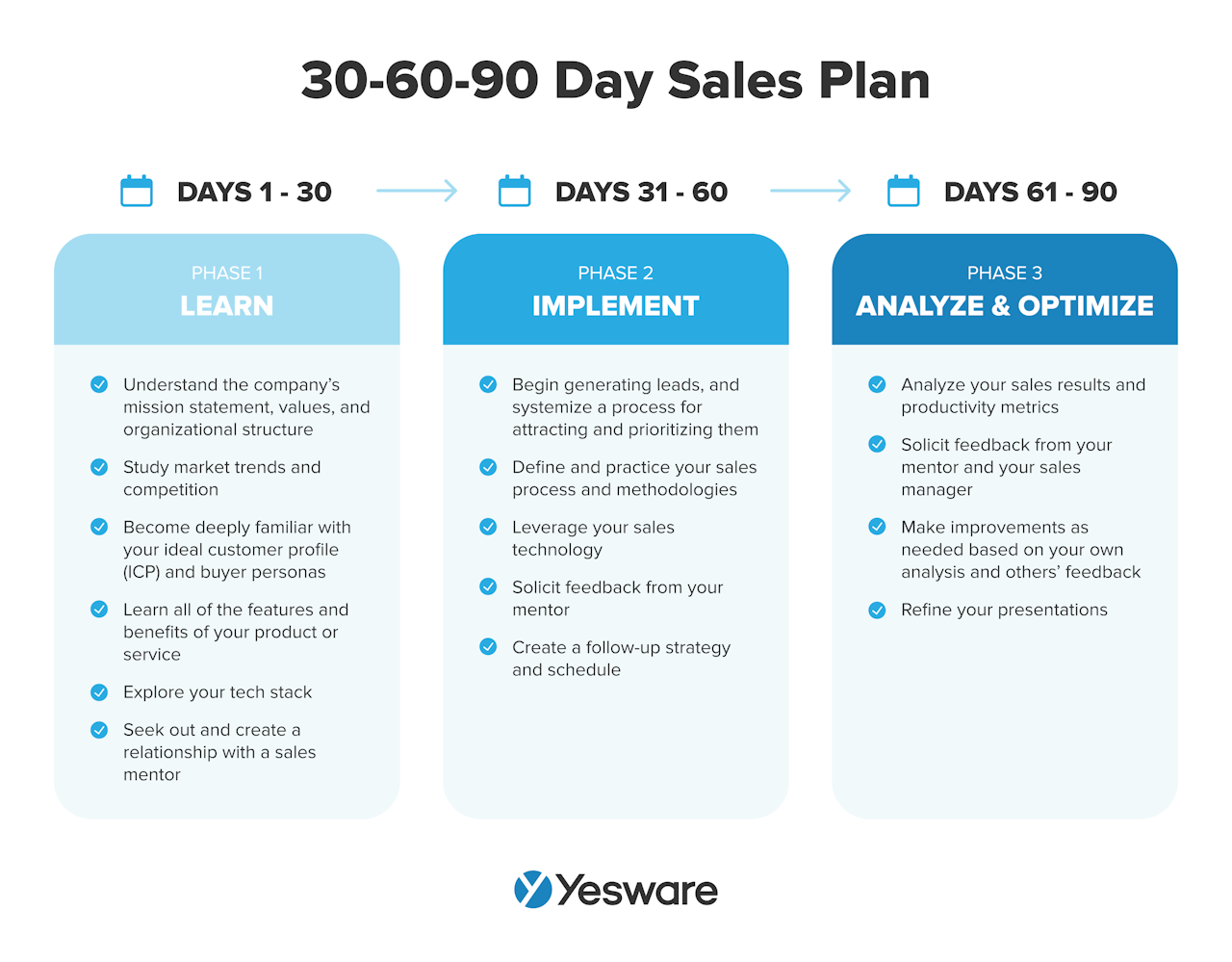
In general, the first 30 days of the 30-60-90 day sales plan are spent learning everything they can about the company, its product and customers, and its sales process.
Days 30 through 60 are for putting the plan into action. Sales reps should jump into the sales process and track their progress, challenges, and successes. These will be analyzed later in order to optimize the process.
Days 61 through 90 are all about fine-tuning the plan. Sales reps should take the data they gathered through the first two phases and use any insights gained to create a new and improved iteration of the sales plan.
Market Expansion Sales Plan
If you’re hoping to start selling to a bigger market, a market expansion sales plan might help structure the process and improve productivity and results.
A market expansion sales plan outlines what a sales team must do in order to successfully expand into a new market or territory. Most often, this kind of plan addresses expanding into a new geographic market.
A market expansion plan should address distribution efforts to the new territory, as well as time zone issues and other logistical considerations.
Revenue-Based Sales Plan
A revenue-based sales plan is based on — no surprise here — revenue.
This type of sales plan focuses on sales forecasting and strategies to improve conversion rates in order to close more deals and improve the bottom line.
How to Measure Sales Progress
There are a number of ways to use your sales plan to measure your sales progress. Remember, your sales plan is a living, breathing document and should be scrutinized and updated as often as needed to reflect your current sales team, product pricing, market conditions, and sales tactics.
As your sales plan changes over time, your measurable metrics may need updating, as well. Consider tracking some of the following KPIs to keep your finger on the pulse of your team’s progress.
Revenue
Revenue is one of the most straightforward metrics to track, but keep in mind that there are many ways to approach this. You can measure revenue in one or several of the following ways:
- Overall revenue
- Revenue by product
- Revenue from new customers vs. existing ones
- Revenue by territory or market
If you only track overall revenue, you lose out on valuable insights for growth. Your total revenue, for example, might look healthy, but a closer look could reveal that it’s streaming almost entirely from existing customers. Tracking revenue from new customers would highlight the fact that your company needs to focus on customer acquisition in order to continue generating new business.
Sales Activities
You can also track the day-to-day behavior and sales activities of your sales team. Consider monitoring things like:
- Calls
- Emails
- Social media engagement
- Scheduled meetings
- Demos and presentations
- Referrals
Remember, none of this is meant to spy on your sales team or micromanage their progress. Instead, the goal is to promote growth and efficiency.
Funnel Metrics
The sales cadence is another lens through which to analyze your team’s progress. Take a bird’s eye view of your sales pipeline and start tracking some of the following:
- Length of sales cycle
- Number of closed deals
- Number of deals that didn’t close after reaching a certain stage
- Value of the pipeline by individual and team, by month and by quarter
- Average contract value
- Conversion rate
Tracking these metrics will help you see any kinks in the overall process.
Lead Generation Metrics
When you track your lead generation progress, you can get valuable data about how effectively you’re reaching your target customers. The following data will help you set benchmarks and reach your business goals.
- Volume of new opportunities
- Lead response time
- Percentage of follow up
- Dropped leads
- Qualified leads
- Customer acquisition cost
If any of these metrics are lagging, you may want to work with your marketing or content teams and reconsider your marketing strategy.
Sales Productivity Metrics
Sales productivity metrics are great for seeing where your reps’ sales efforts are going. These metrics can be a bit more tedious to measure and track, but are well worth studying in the long run.
- Percentage of time
- Selling
- Entering data
- Creating content
- Number of sales tools used
- Percentage of lead follow-up
Time is money, and knowing where your time is going has a direct impact on your bottom line.
What to Include in a Sales Plan Template
Ultimately, it’s up to sales teams (ideally in collaboration with marketing) to decide what information will be most useful to them within a sales plan.
Here are some of the more common components that teams include in their sales plans.
Mission Statement
A company’s mission statement gives a high-level, goal-oriented synopsis of its purpose and how it serves the market.
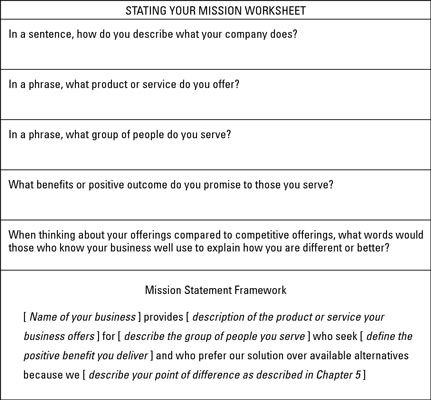
Although this isn’t necessarily an actionable component of the sales process, it’s good to include it in the plan so that it’s front of mind as your team works to meet the goals laid out in the sales plan.
Target Customers
Your sales plan should always outline who your offer is best-fit to serve.
At a minimum, your sales and marketing teams should collaborate to define the ICP and buyer personas. But certain sales plans need to go beyond the basics and define their target market into subgroups. Some examples of customer segments might include:
- Referrals
- Renewals
- Upsells and cross-sells
- New leads
Your target customer segments can also be defined by geography, demographics, and company size — just to name a few.
Team Structure
Many teams also include a section that succinctly outlines the people involved in the sales process, and their specific roles and responsibilities.
Effective sales plans outline roles and DRIs, so it’s a good idea to ensure that everyone has access to the roster, so to speak, as they execute the sales plan. This is especially important for larger sales teams.
Sales Goals and Revenue Targets
Every sales plan needs to include the goals it aims to achieve.
Remember to follow the SMART goal framework; our goals should be specific, measurable, achievable, relevant, and time-bound.
It’s especially important to make clear in your sales plan how your team plans to track your progress toward those goals. How and when will you monitor/measure performance? What are the performance benchmarks you’re hoping to achieve in a given time period? These specifics should be outlined in full in your sales plan.
Tip: Data shows that half of sales experts set their sales goals a quarter in advance.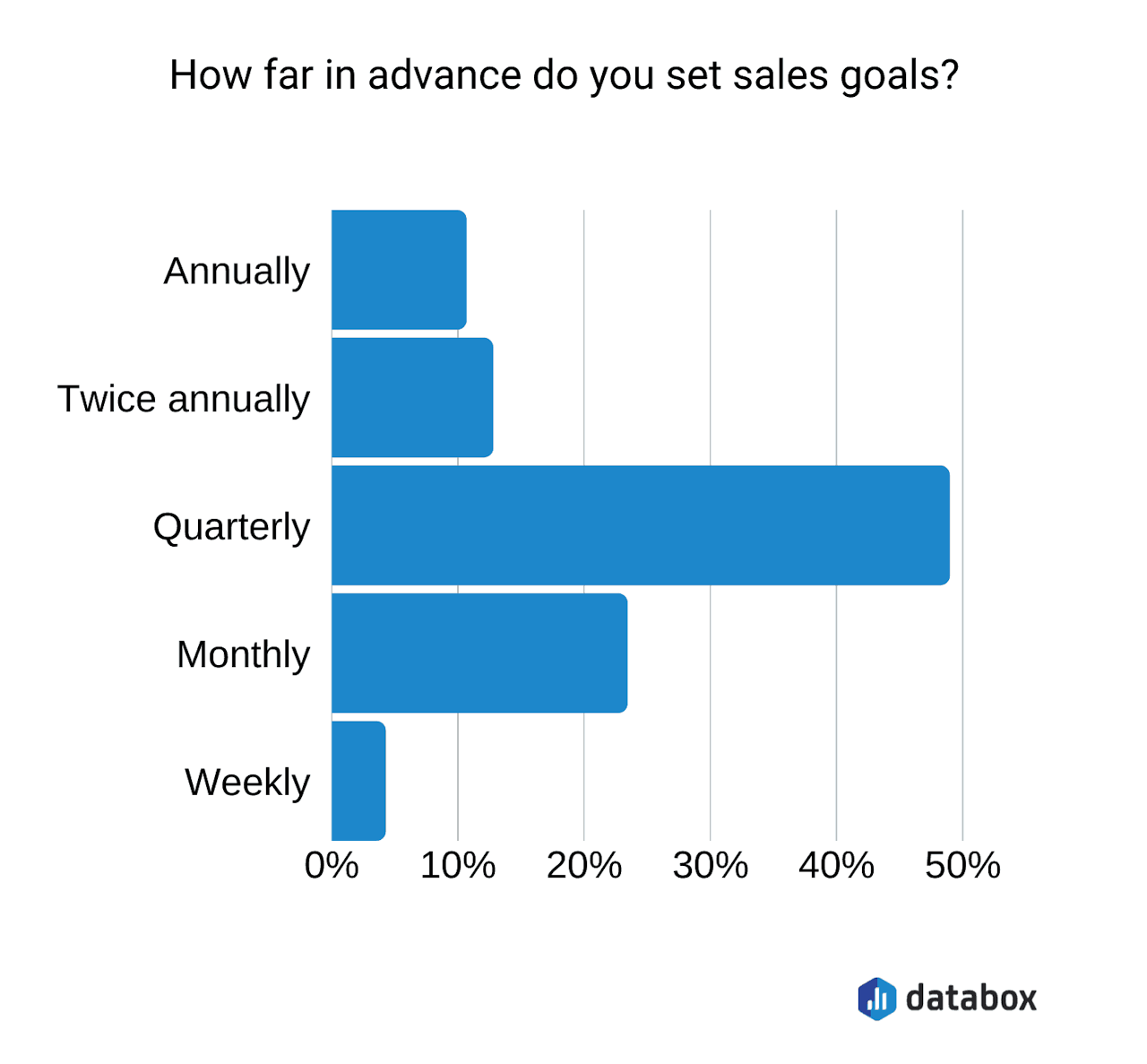
Performance During the Prior Period
You can give your sales plan context by including data about your team’s past performance in your goal areas. This helps salespeople understand how much of a gap they need to fill in order to succeed.
Strategies and Tactics
Your sales plan must include details about the specific strategies, tactics, and/or methodologies your team will use to reach their goals. This section should be action-oriented and aligned with the unique buyer’s journey of the target market.
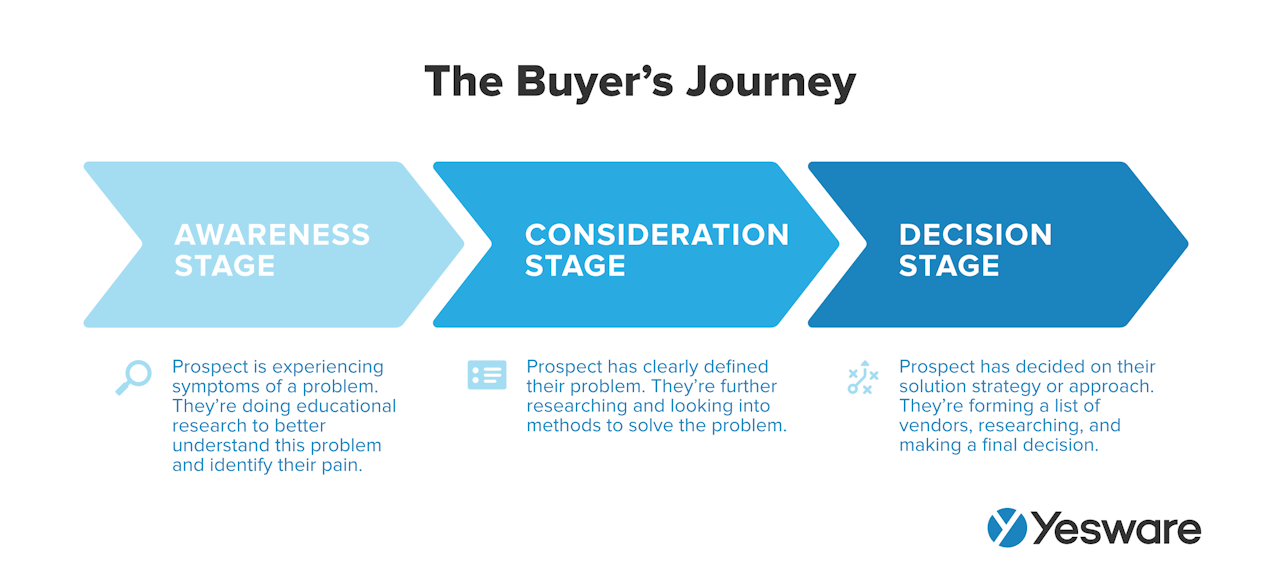
You’ll also want to include details and actionable insights about any specific sales strategies you want your team to use.
Pricing and Promotions
Most sales plans will also need to include at least basic information about your offer’s pricing structure, and whether or not you plan to offer any promotions.
Be thoughtful about these numbers, especially promotions. Sales teams need to strike a fine balance between attracting customers with hard-to-refuse deals and making enough profit to affect the bottom line in a meaningful way.
Deadlines and DRIs
Every sales plan needs to include clear information about who is responsible for which deliverables, and when those deliverables are due.
Everyone on the team needs to be clear on the DRIs (directly responsible individuals) for each step of the plan.
A timeline can also be a very helpful visual component of a sales plan.
Resources
It’s also a good idea to include an overview of the resources and/or tools your team will need to use in order to execute the plan successfully.
Resources might include a CRM system, project management software, sales enablement tools, forecasting software, or a sales dashboard. You should also include a breakdown of the budget.
Market Conditions
You can also add some context to your sales plan by including insights about the current state of the market.
Information about general trends and potential disruptions in the industry can help motivate your sales reps to buy into your sales plan, as well as help them know how to approach their responsibilities. You’ll also want to include an in-depth competitive analysis.
Sales Plan Template
Below you’ll find a basic sales plan template that you can copy and paste as a starting point. Remember, the sales plan is meant to be highly specific to your company, so it’s likely that the template here will not meet all of your needs. Instead, treat it as a jumping-off point and customize it until it captures all of the pertinent information.
[COMPANY NAME]
SALES PLAN [YEAR]
1. Mission Statement
2. Goals
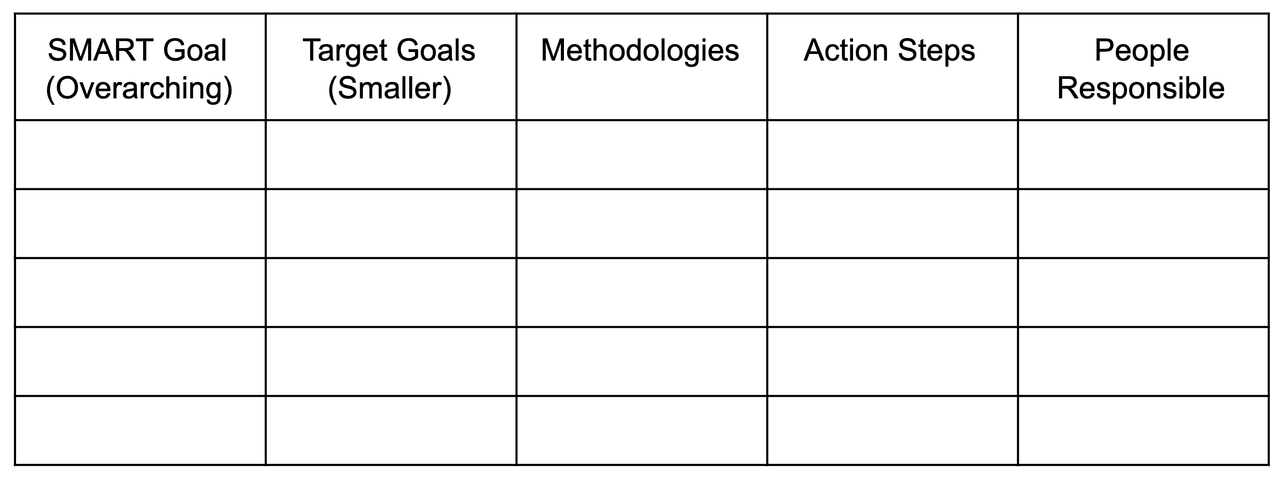
3. Sales Team Organization
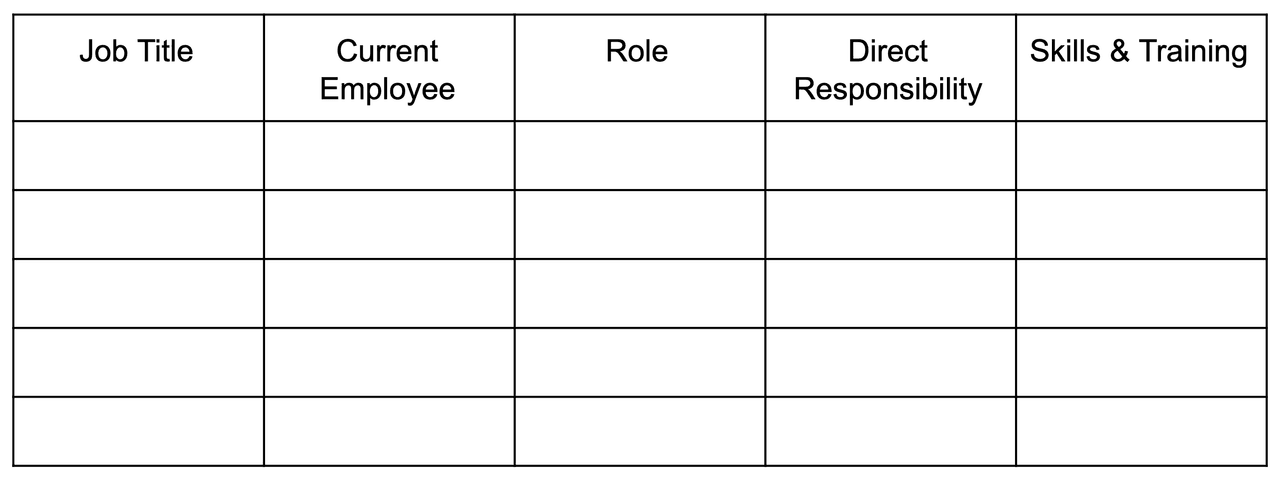
4. Target Market
- Demographics (Age, Marital Status, Location, Profession, Etc.):
- Goals:
- Values:
- Challenges:
- Pain Points:
- Objections:
5. Sales Methodologies
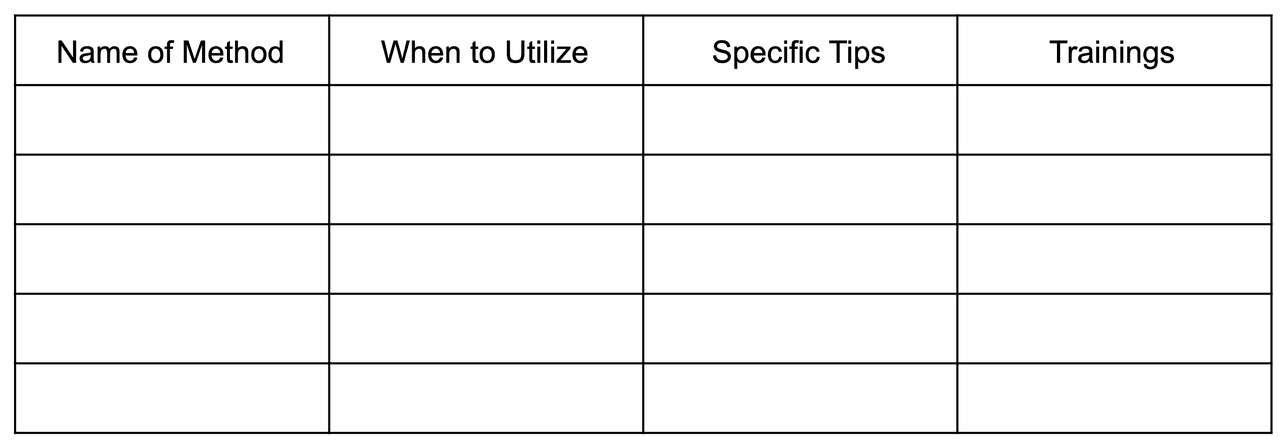
6. Action Plan
[This section is highly specific to your preference. Consider formatting as a list, table, or flowchart.]
7. KPIs
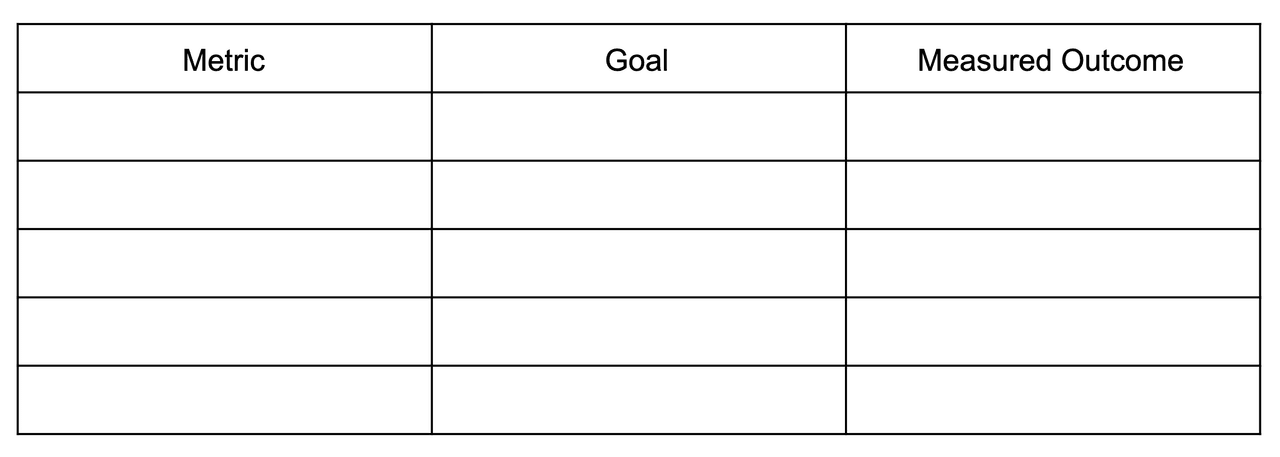
Sales Plan Examples
Here are a few examples of sales plans to fit a variety of scenarios. Remember, these are intended to be templates or starting points; they should be tweaked or changed to fit the unique needs and goals of your team.
Basic Sales Plan Template
Best Templates offers a comprehensive and straightforward sales template that can be adapted to fit just about any sales goal.

Simply download the template and fill in each section with relevant data and information. This template includes sections for goals, lead demand generation, implementation, and progress tracking.
Single Page Sales Plan
If you’re going for brevity, a one-sheet sales plan might be a good fit for your team.
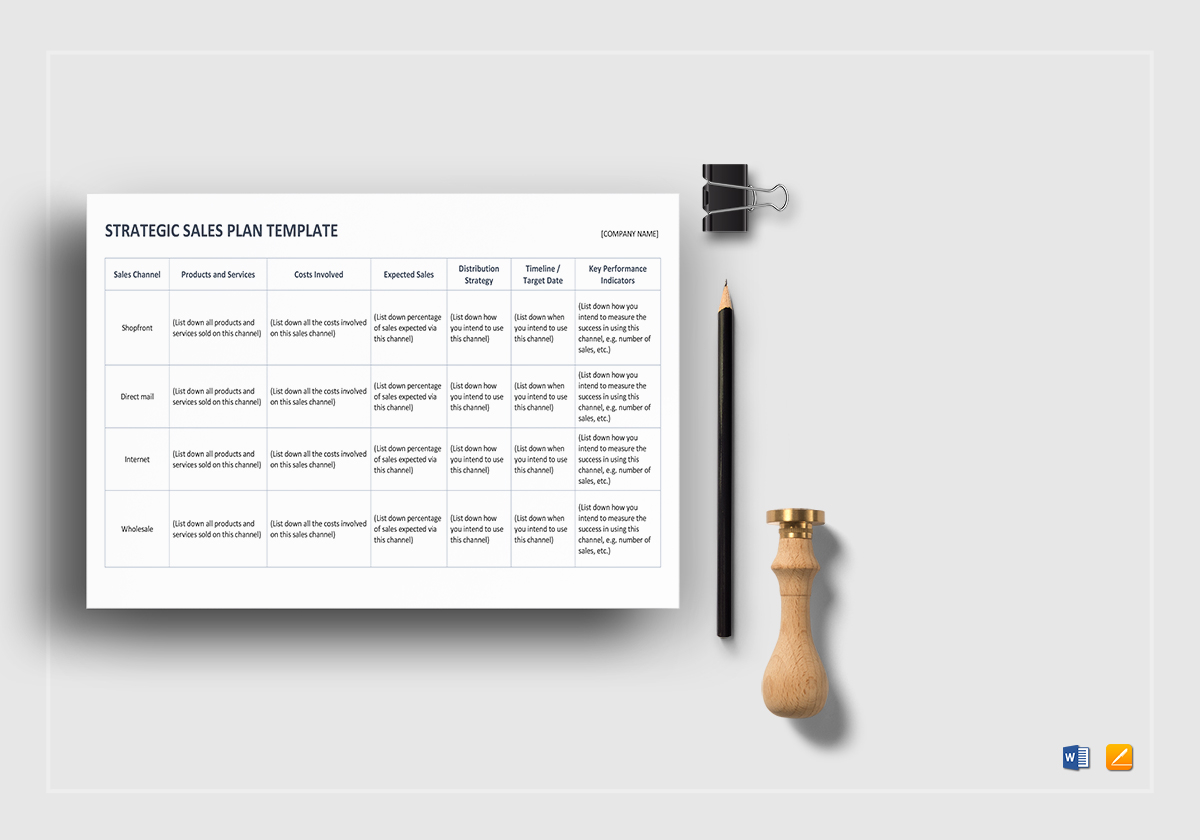
This template gets right down to brass tacks; it includes space for budget details, deliverables, and KPIs.
Customizable and Design-Forward
For a sales plan that’s custom to your needs and looks great to boot, try Venngage. Venngage is an online sales plan creation software that helps sales teams create actionable, visually engaging sales plans.
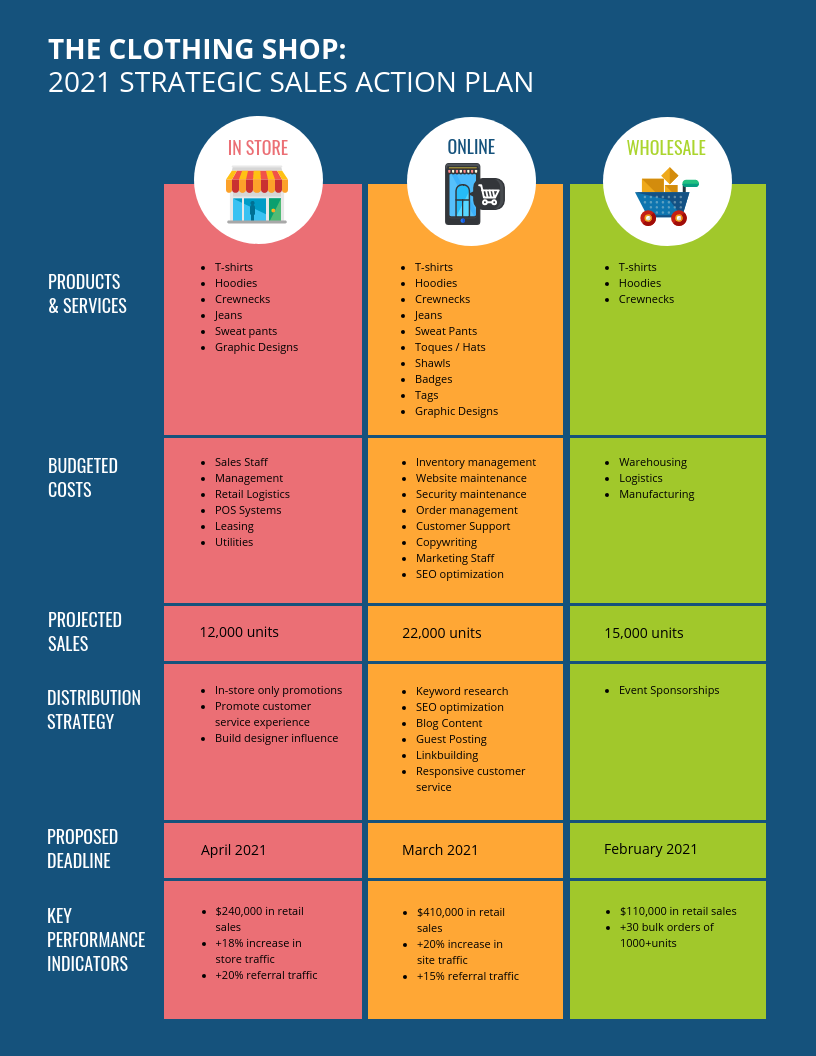
Venngage offers users the ability to choose from dozens of layout templates that they can further customize with charts, photos, and illustrations.
30-60-90 Day Sales Plan
For new hires looking to make an impact right away, a 30-60-90 day sales plan can keep you on track and making progress every day of the first three months. 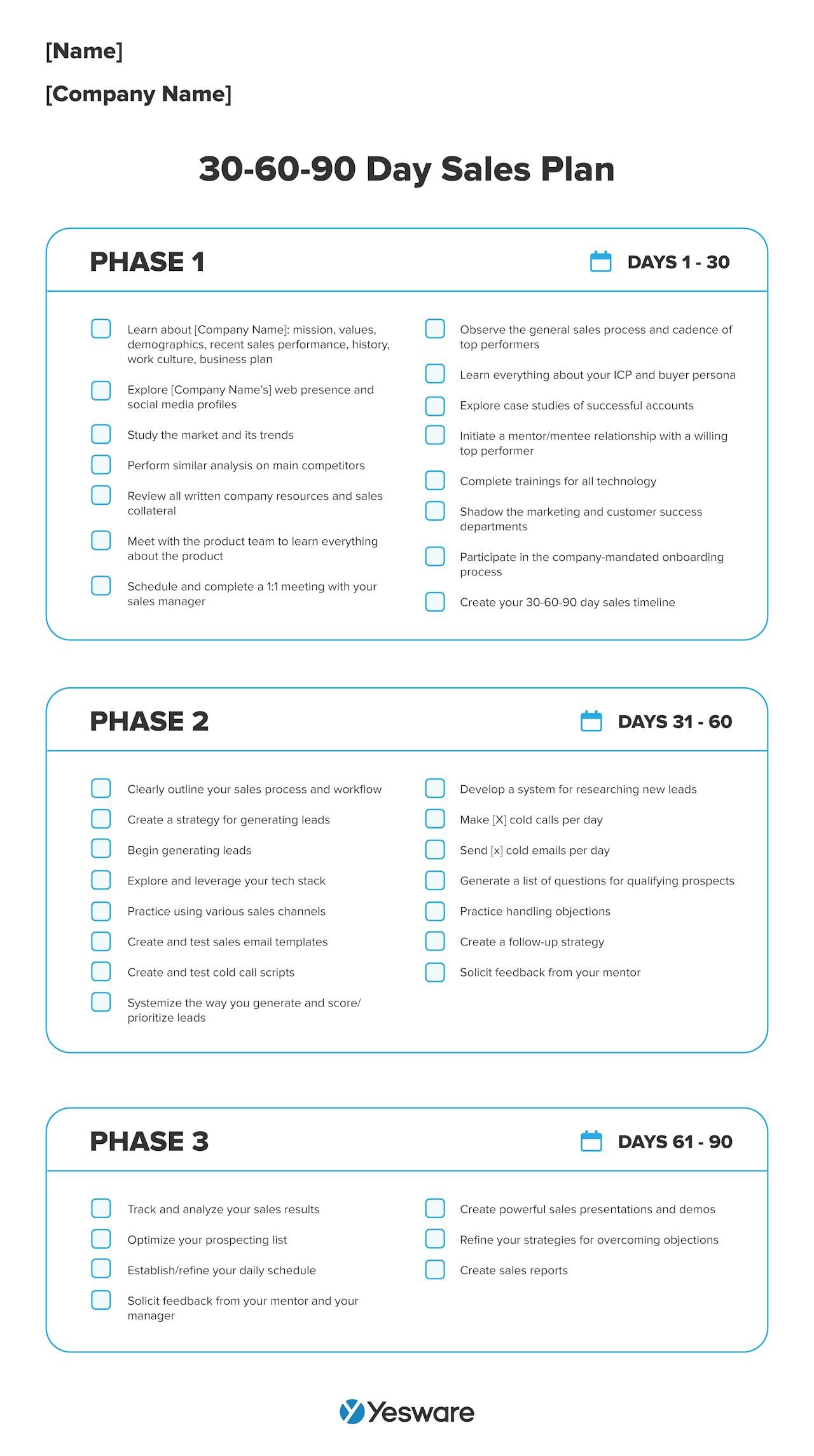 This sales plan is outlined in checklist form, making it easy to keep track of what still needs to be accomplished.
This sales plan is outlined in checklist form, making it easy to keep track of what still needs to be accomplished.
Tip: If you’re interested in the checklist above — grab the Google Docs version of it here.
Microsoft Word Sales Plan
You don’t need fancy sales software to create a sales plan. In fact, Template Lab offers a perfectly capable Microsoft Word template to get you started.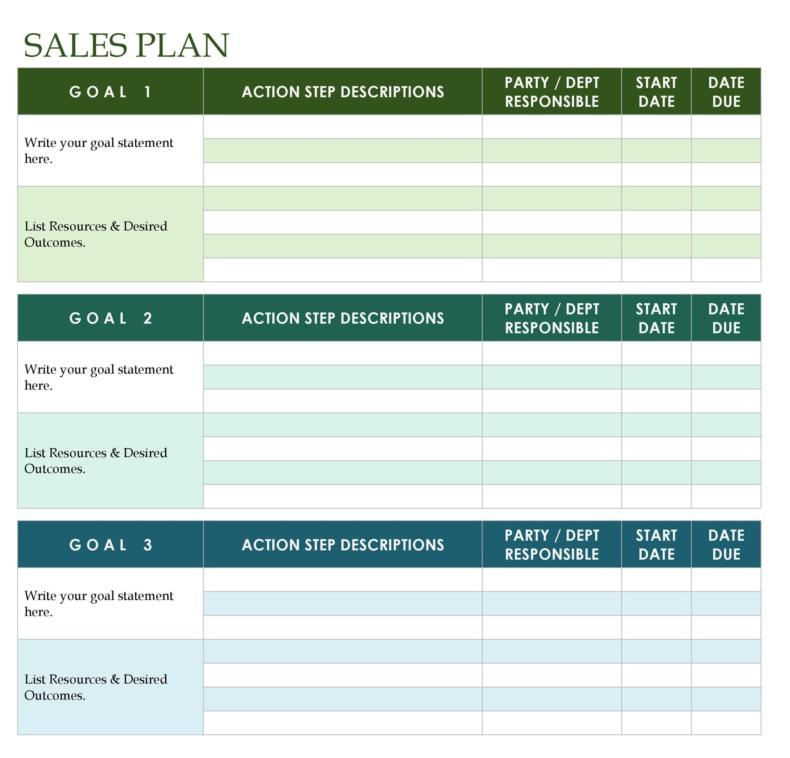
This template allows sales teams to tackle multiple goals at the same time, making it easy to get a bird’s-eye view of how close your team is to achieving both individual targets and big-picture goals.
Tip: Grab more sales plans here –> 13 Strategic Sales Plan Templates
Tips for Creating a Winning Sales Plan
Here are some of our best tips for creating a sales plan that gets results.
Get Input From Marketing
Your sales plan will only be effective if your marketing team can attract the right leads.
It’s essential that sales and marketing teams remain in close collaboration as they create, track, and manage sales plans.
Understand Your Sales Rep’s Challenges
You can enable your sales reps to be most successful by creating your sales plans around their strengths, and taking their challenges into account.
Of course, sales reps will likely always encounter challenges during a deal — that’s to be expected. But the best sales plans are the ones that leverage their team’s strengths to get the job done and have built-in workarounds to address the team’s needs and potential challenges.
Don’t Move the Goal Posts Once It’s Complete
Although it can be tempting, it’s important to finalize your sales plan and refrain from editing it until the given time period is complete.
Your team will be best-served if you stick to the plan, collect data on the process, and use those insights to further optimize your next sales plan.
Get Feedback
Share your sales plan in draft form with members of other teams. Customer success, marketing, and finance teams can all offer valuable insights into how the proposed sales plan fits into the bigger picture of the company’s goals.
Set Individual Goals and Milestones for Your Team
All sales plans should include SMART goals for the sales team. But some of the most effective plans also include SMART goals for each individual sales rep that’s involved. This helps keep everyone on the team accountable.
This guide was updated on November 30, 2022.
Get sales tips and strategies delivered straight to your inbox.
Yesware will help you generate more sales right from your inbox. Try our Outlook add-on or Gmail Chrome extension for free, forever!
Related Articles
Casey O'Connor
Anya Vitko
Melissa Williams
Sales, deal management, and communication tips for your inbox
![2023 Playbook: How to Create a Revenue-Generating Sales Plan [Template + Examples]](/blog/_next/image/?url=https%3A%2F%2Fwww.yesware.com%2Fwp-content%2Fuploads%2F2021%2F05%2Fsales-plan-yesware.jpg&w=1984&q=75)
